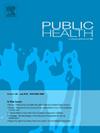内部生活:揭示印度孕妇使用无烟烟草的模式和相关关系
IF 3.9
3区 医学
Q1 PUBLIC, ENVIRONMENTAL & OCCUPATIONAL HEALTH
引用次数: 0
摘要
目的怀孕期间吸烟是一个值得关注的问题,因为它与孕妇及其胎儿的不良后果有关。印度妇女普遍使用无烟烟草。然而,印度缺乏关于怀孕期间无烟烟草使用及其决定因素的研究。该研究调查了印度孕妇中无烟烟草使用的流行程度和预测因素、戒烟尝试、医疗保健提供者的戒烟建议以及戒烟意图。该研究利用了全球成人烟草调查(GATS) 2(2016-17)印度的数据。第二次服务贸易总协定在所有30个邦和两个联邦属地进行。服务贸易总协定是对年龄在15岁或以上的个人进行的具有全国代表性的家庭调查。对城市和农村地区分别进行了多阶段抽样。方法本研究的样本量为1403名正在接受调查的孕妇。采用双因素分析、多因素回归、卡方检验和phi系数分析。结果7.4%的孕妇报告使用无烟烟草,在年龄较大的年龄组、预定部落、较贫穷的家庭以及东北部和东部地区最高。约64.4%的人访问过卫生保健提供者,但只有23.7%的人被问及烟草使用情况,20.2%的人被建议戒烟。43.6%的人尝试过戒烟,只有20%的人计划在12个月内戒烟。年龄、种姓、教育、职业和居住地是烟草使用的统计显著预测因子,但对无烟烟草使用的不良影响的了解不具有统计学意义。结论:解决印度孕妇使用无烟烟草问题需要采取多方面的方法,结合有针对性的干预措施、加强医疗保健提供者的支持、健康教育活动和基于证据的政策。健康教育和提高认识运动应传播关于怀孕期间使用无烟烟草对母亲和儿童的危险的准确和全面的信息。本文章由计算机程序翻译,如有差异,请以英文原文为准。
Life within: Unraveling the patterns and correlates of smokeless tobacco use in pregnant women across India
Objectives
Tobacco use during pregnancy is of significant concern as it is associated with adverse outcomes in expecting mothers and their fetuses. Smokeless tobacco use is widespread among women in India. However, there is a dearth of studies on smokeless tobacco use and its determinants during pregnancy in India. The study examines the prevalence and predictors of smokeless tobacco use, quit attempts, advice from healthcare providers to quit, and intentions to quit among pregnant women in India.
Study design
The study utilizes the Global Adult Tobacco Survey (GATS) 2 (2016–17) India data. GATS 2 was conducted in all 30 states and two union territories. GATS is a nationally representative household survey of individuals aged 15 years or above. A multistage sampling procedure was conducted separately for urban and rural areas.
Methods
The sample size for the study was 1403 currently pregnant women at the time of the survey. Bivariate analysis, multivariable regression, Chi-square test, and phi coefficient were utilized.
Results
Smokeless tobacco use was reported by 7.4 % of pregnant women, highest among older age groups, Scheduled Tribes, poorer households, and North-Eastern and EAG states. About 64.4 % visited a healthcare provider, but only 23.7 % were asked about tobacco use, and 20.2 % were advised to quit. Quit attempts were made by 43.6 %, and only 20 % planned to quit within 12 months. Age, caste, education, occupation, and state of residence were statistically significant predictors of tobacco use, but not knowledge of the ill effects of smokeless tobacco use.
Conclusions
Addressing Smokeless tobacco use among pregnant women in India requires a multifaceted approach combining targeted interventions, strengthened healthcare provider support, health education campaigns, and evidence-based policies. Health education and awareness campaigns should disseminate accurate and comprehensive information about the risks of smokeless tobacco use during pregnancy on mother and child.
求助全文
通过发布文献求助,成功后即可免费获取论文全文。
去求助
来源期刊

Public Health
医学-公共卫生、环境卫生与职业卫生
CiteScore
7.60
自引率
0.00%
发文量
280
审稿时长
37 days
期刊介绍:
Public Health is an international, multidisciplinary peer-reviewed journal. It publishes original papers, reviews and short reports on all aspects of the science, philosophy, and practice of public health.
 求助内容:
求助内容: 应助结果提醒方式:
应助结果提醒方式:


